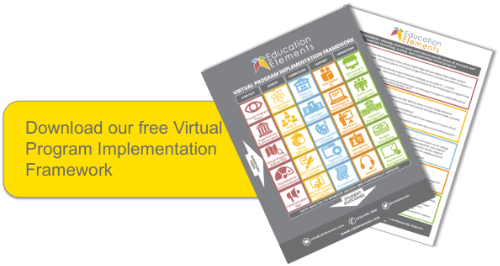Virtual schools in the K-12 environment have been a popular topic for discussion for many years. Recently I have noticed an increased level of interest by online charter school leaders, district- or state-run virtual schools, and program leaders in regards to how they can improve their virtual schools.
Almost ironically, I also find myself having frequent conversations about virtual school opportunities with brick-and-mortar school leaders. With many school districts adopting blended learning as a major priority, these leaders clearly see the need for comprehensive virtual programs that meet the demands of a highly mobile student population and a highly customized society.
Much of my time during these conversations is spent listening and suggesting that leaders answer three main questions about virtual school:
1. Whom do you want to serve in your virtual school?
- Knowing who you serve is one of the most fundamental building blocks for a virtual school’s success. There are many types of populations that a virtual school or program can serve. They vary by academic advancement level, grade level, language, racial diversity, extracurricular focus, and so on. A virtual program leader must recognize the types of students that the school is aiming to serve and the unique needs of those student groups. With a clear understanding of the school's targeted student population, leadership can provide the right depth of curriculum, instructional model(s), and appropriate support system.
- One way I quickly know whether a virtual school is/will be successful is by examining whether there is a strong support community. This includes school’s academic and social advisor system, student engagement plans, family communication channels, school board involvement, and structures that allow student voice. From my own observations, this community support element is significantly lacking in most virtual schools or programs that are known as notoriously poor. Leaders of excellent virtual programs believe very strongly in the importance of having a strong community integrated into their digital experience and put a lot of care into nurturing a support system that is holistic and dynamic.
- For example, intervention programs administered by virtual family coaches can provide the differentiated instruction that virtual school students need and deserve. Or, maybe that differentiation and personal care is provided by virtual or on-site tutors (at a central location like a tutoring center) to allow for additional 1-on-1 help.
- In my experience, this question is often a very hard one for virtual program leaders to answer. Leaders will tell me, “We use XYZ company’s math curriculum and ABC company’s language arts program, and I think their curricula are strong.” But when I ask them to unpack "strong," I don't hear how the digital curricula maps to the needs of their students, their curriculum scope and sequence, and supplementary content like Open Education Resources (OER).
- To expand on the need to consider OER: Virtual school curriculum has traditionally been provided by large digital content or publishing companies. Yet with advances in technology and changes in our expectations of online learning, we demand that curriculum become more on-demand and interoperable with multiple systems. In addition to the main curriculum content, OER can be a very powerful and effective teaching tool to satisfy those needs. Leaders who recognize the need for a diverse set of digital curricula that utilizes OER and other web content are more likely to create personalized online experiences and lead their virtual program into excellence.
One additional trend I see in the virtual school space is that leaders are recognizing the need for finding the right partners to set their program up for success. They know they do not need to do this alone -- virtual school is a new frontier of learning, one that requires increased collaboration, not isolation.
I am grateful to constantly engage in conversations with virtual school leaders. Those engagements and experiences drive me to think critically about the ways we can make virtual schooling an experience that meets or perhaps even surpasses that of conventional brick-and-mortar education.
If you want to know more about what other questions my team and I engage in with virtual school leadership, check out our virtual program implementation framework.





